Cereus peruvianus (Peruvian apple cactus) Profile
Written by Iris
Oct 13 2021
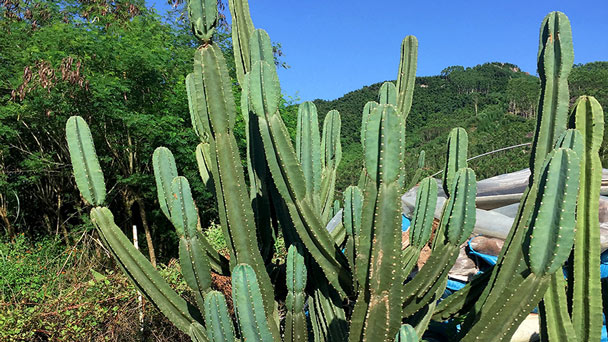
Also known as columnar cactus, Cereus peruvianus is a fast-growing cactus with beautiful night flowers. During the summer months, the nodes of the cactus produce flowers. This cactus is native to South America.
Flowers which are generally produced on large specimens only, are about 15cm (6 inch) long and have white petals tinged with brownish green. cereus peruvianus flowers in summer and opens at night time. Each flower blooms only one night and then dies.
The flowers are followed by red fruits 2.5-5cm (1-2 inch) in diameter.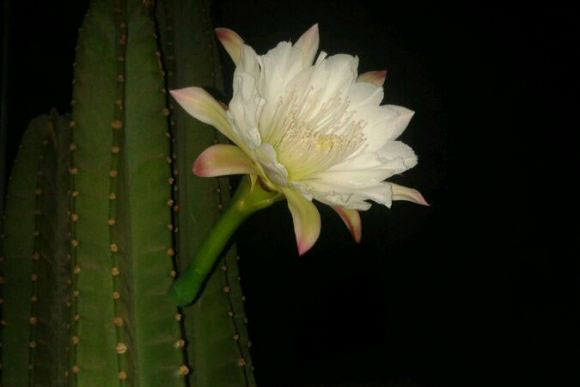
Here is an insight on how to go about the procedure:
Identify a mature Cereus peruvianus (Peruvian apple cactus) plant – A mature plant has several stem extensions from the main stem.
Make a cutting on the stem top part of the Cereus peruvianus – Carefully make a smooth cutting on the top side of the stem you intend to propagate.
Allow the cutting to dry for about a week or two – Allow the cutting to dry out undisturbed for about one week before planting the dried cutting in an ideal potting medium.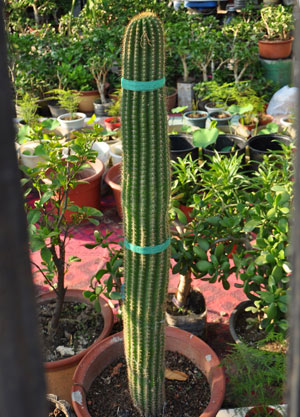
Identifying the type of nutrients missing in the soil is a crucial step to consider before adding extra fertilizer. Collect a soil sample and take it to the lab for analysis to gain a better understanding of the soil’s nutrient quality.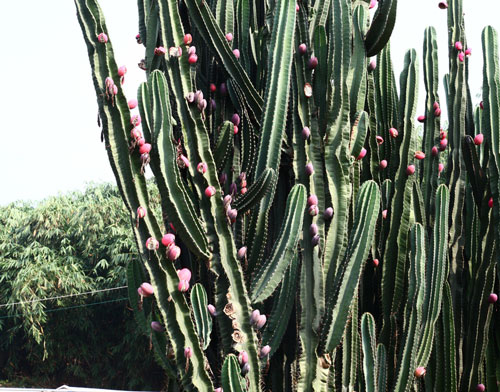
Like many edible cactus fruits, the fruit produced by the peruvian apple cactus is rich in natural sugars, vitamins, and minerals. The tasty white flesh contains high levels of beta-carotene, a precursor to vitamin A, along with Vitamin C, dietary fiber, and more. Eating cereus fruits can help to enhance immune functioning and improve digestion.
Landscape Uses
Cereus peruvianus can be used as a windowsill plant, but mainly as a floor plant as it grows tall. As houseplants Cereus peruvianus will bring an exotic air to interiors where they are.
Observations and statistics of scientists have shown that Cereus peruvianus neutralizes harmful electromagnetic waves emitted by the television, telephone, computer, thus placing the plant in those areas of the house where the electronics are placed is beneficial.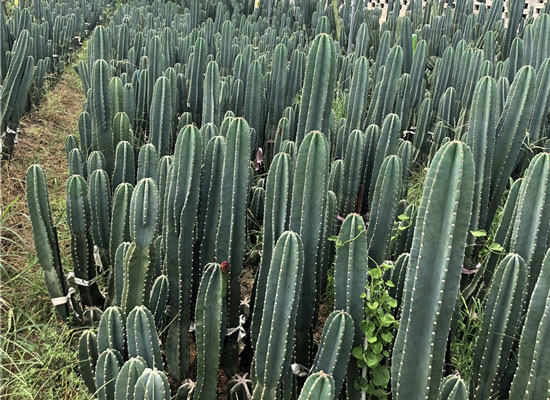
Cereus hildmannianus-A flowering plant that produces white flowers on occasional bloom.
Produces edible fruit.Features cylindrical segmented stems.
Cereus tetragonus-Native to North America Reach considerable heights and are often mistaken for fairy tale castles, common and dwarf succulents
If you do want to care for your cactus, the best way to proceed is to cut off all of the old bloom stalks, to keep rotting material off of your cactus, to remove all of the old mummies to prevent mold, and to use a light fertilizer when it starts to bloom. Not all cacti need the same care, however. The Cereus Peruvianus will need high amounts of potassium and magnesium while it is in bloom, but after it is done, the nutrients are of no use to the plant. Instead of watering the cactus with fertilizer, apply a magnesium spray to prevent more flowers.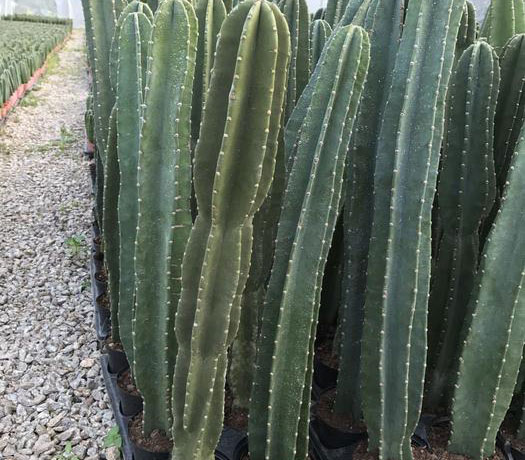
Cereus peruvianus InfoCereus peruvianus Ecological HabitsCereus peruvianus DistributionHow to Grow and Care for Cereus peruvianusHow to Grow Cereus peruvianusHow to Care for Cereus peruvianusUses of Cereus peruvianusVarieties of Cereus peruvianus (Peruvian apple cactus)Cereus peruvianus (Peruvian apple cactus) Common Pests/DiseasesCereus peruvianus Design Tips
Cereus peruvianus Info
| Common Name(s) | Apple cactus, Peruvian torch, column cactus, hedge cactus, screw cactus plant |
| Scientific Name | Cereus peruvianus or Cereus repandus |
| Family | Cactaceae |
| Growing Zone | 8-11 |
| Light | Full sun to partial shade with bright light |
| Water | Water thoroughly during the active growth phase, allow the soil to dry between watering, minimal watering during winter |
| Soil | Well-drained cactus soil having an abundance of sand |
| Fertilizer | Slow-release fertilizer throughout the growing season |
Cereus peruvianus Ecological Habits
Cereus peruvianus is a bluish green single column that branches out toward the top in the wild, but is unlikely to do o as a potted plant. I has five to eight broad, prominent notched ribs separated by deep, narrow indentations. Areoles in the notches are filled with white hairs and each areole bears a cluster of about seven brown spines, which are unlikely to grow more than 1-2cm (0.4-0.8 inch) long indoors.Flowers which are generally produced on large specimens only, are about 15cm (6 inch) long and have white petals tinged with brownish green. cereus peruvianus flowers in summer and opens at night time. Each flower blooms only one night and then dies.
The flowers are followed by red fruits 2.5-5cm (1-2 inch) in diameter.
Cereus peruvianus Distribution
Cereus peruvianus is a large, erect, thorny columnar cactus up to 9m (30 feet) tall when growing in the wild. Though less gigantic in pots, they are much admired for their sculptural, columnar shape, which contrasts impressively with that of most other plants in any collection of cacti. Cereus peruvianus is native from rocky outcrops and the savanna in South America.
How to Grow and Care for Cereus peruvianus
How to Grow Cereus peruvianus
- With Seeds
- With Stem Cuttings
Here is an insight on how to go about the procedure:
Identify a mature Cereus peruvianus (Peruvian apple cactus) plant – A mature plant has several stem extensions from the main stem.
Make a cutting on the stem top part of the Cereus peruvianus – Carefully make a smooth cutting on the top side of the stem you intend to propagate.
Allow the cutting to dry for about a week or two – Allow the cutting to dry out undisturbed for about one week before planting the dried cutting in an ideal potting medium.
- With Offsets

How to Care for Cereus peruvianus
- Light
- Soil
- Water
- Temperature and Humidity
- Fertilizer
Identifying the type of nutrients missing in the soil is a crucial step to consider before adding extra fertilizer. Collect a soil sample and take it to the lab for analysis to gain a better understanding of the soil’s nutrient quality.
- Pruning

Uses of Cereus peruvianus
Nutritional UsesLike many edible cactus fruits, the fruit produced by the peruvian apple cactus is rich in natural sugars, vitamins, and minerals. The tasty white flesh contains high levels of beta-carotene, a precursor to vitamin A, along with Vitamin C, dietary fiber, and more. Eating cereus fruits can help to enhance immune functioning and improve digestion.
Landscape Uses
Cereus peruvianus can be used as a windowsill plant, but mainly as a floor plant as it grows tall. As houseplants Cereus peruvianus will bring an exotic air to interiors where they are.
Observations and statistics of scientists have shown that Cereus peruvianus neutralizes harmful electromagnetic waves emitted by the television, telephone, computer, thus placing the plant in those areas of the house where the electronics are placed is beneficial.

Varieties of Cereus peruvianus (Peruvian apple cactus)
Cereus Jamacaru-Tall plant growing to over 20ft. Flowering plant and produces edible fruitCereus hildmannianus-A flowering plant that produces white flowers on occasional bloom.
Produces edible fruit.Features cylindrical segmented stems.
Cereus tetragonus-Native to North America Reach considerable heights and are often mistaken for fairy tale castles, common and dwarf succulents
Cereus peruvianus (Peruvian apple cactus) Common Pests/Diseases
If your Cereus is in bloom, your plants are extremely vulnerable to getting diseases and pests. They are old and tired at this point and it is a good time to take a break from watering and fertilizing. The purpose of resting is so that your cactus can use all the energy it has stored up to produce the giant flowers that will soon be on display.If you do want to care for your cactus, the best way to proceed is to cut off all of the old bloom stalks, to keep rotting material off of your cactus, to remove all of the old mummies to prevent mold, and to use a light fertilizer when it starts to bloom. Not all cacti need the same care, however. The Cereus Peruvianus will need high amounts of potassium and magnesium while it is in bloom, but after it is done, the nutrients are of no use to the plant. Instead of watering the cactus with fertilizer, apply a magnesium spray to prevent more flowers.

Cereus peruvianus Design Tips
The Peruvian apple cactus is a popular ornamental plant that creates an all-natural architecture for gardens and greenhouses alike. With just a little bit of care and attention, this plant can grow to impressive heights and add a unique element to your floor plan or landscape design. Many gardeners also grow this variety of cactus for its exotic flowers and edible fruits. Versatile and visually appealing, the peruvian apple cactus is a low-maintenance centerpiece for the both the home and the garden.Latest Updated
- Benefits of Bugleweed - 7 Science-backed Health Benefits
- Bugleweed Dangers & Side Effects - Is It Poisonous?
- How to Plant Evergreen Trees - What You Should Know
- When to Plant Evergreens - Grow Guide for Evergreen Trees
- 12 Wonderful Evergreen Shrubs for Your Garden
- 12 Popular Evergreen Plants with Pictures for Beginners
- When And How To Prune A Lilac Bush Like a Pro
- How to Grow & Care for Lilac Vine (Hardenbergia Violacea)
- Japanese Lilac Tree (Syringa Reticulata) Care & Propagation Guide
- Shumard Oak Pros and Cons - What to Know
Popular Articles
- Winter maintenance of Antirrhinum Majus
- How to Grow Terminalia Mantaly Tree
- How to Grow and Care for Crossostephium Chinense
- How to grow Antirrhinum Majus in spring
- Peristeria Elata (Dove Orchid) Profile: Info & Care Guide
- Underwatered Snake Plant (Sansevieria Trifasciata) - Signs And How To Fix
- How to Care for Brazilian Jasmine Plant (Mandevilla Sanderi)
- How to Grow & Care for Graptopetalum Purple Delight in Summer
- Rosa Chinensis (China Rose): Plant Growing & Care Tips
- How to Care for Baby Sun Rose (Aptenia Cordifolia)